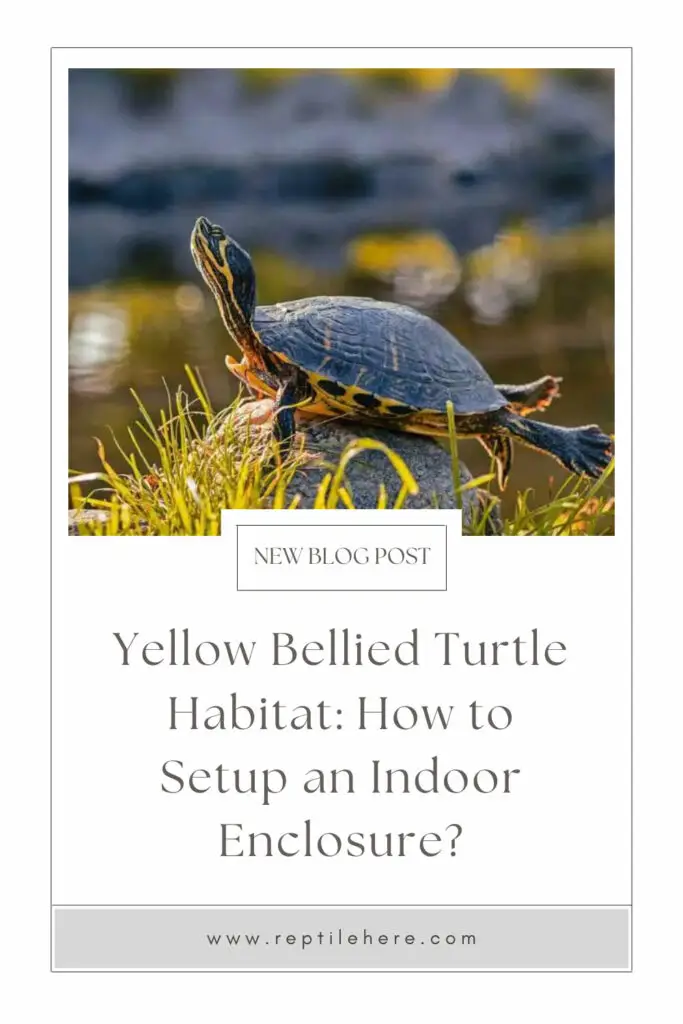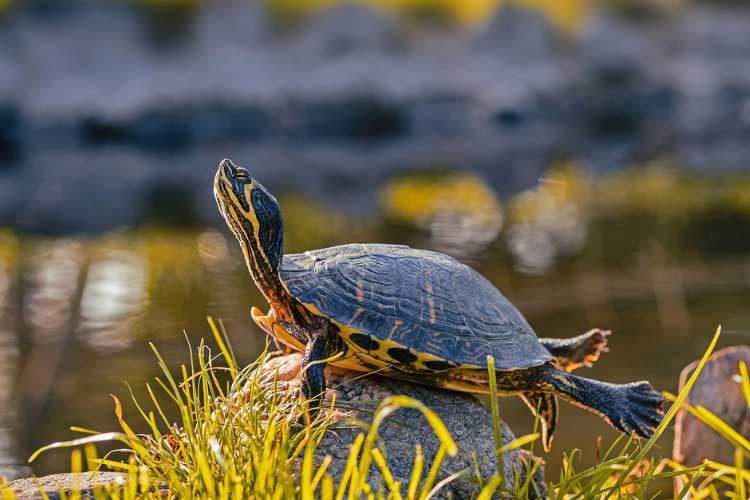Yellow Bellied Turtle Habitat: How to Setup an Indoor Enclosure?
Do you own a yellow-bellied turtle but are not sure what size of tank to get for it or what to put in its tank? If yes, this guide is for you. Proper housing for your yellow belly turtle habitat is crucial for your turtle’s survival. So how do you set it up?
Yellow-bellied turtle habitat should have a spacious tank with plenty of swimming area, a basking platform, UV light, a heat source, and decoration inside the tank to create a natural environment illusion.
We have put together the complete guide below to teach you how to come up with a complete yellow-bellied turtle habitat. You’ll learn all the key things you need to put in your turtle tank plus other helpful tips.
Things you’ll need to set up a yellow belly turtle habitat:
Contents
To set up a complete yellowbelly turtle tank where your pet can live happily and comfortably, you’ll need the following list of items:
- Appropriate tank size
- Water heater
- Heat lamp
- Aquarium water filter
- UVB light
- Basking area
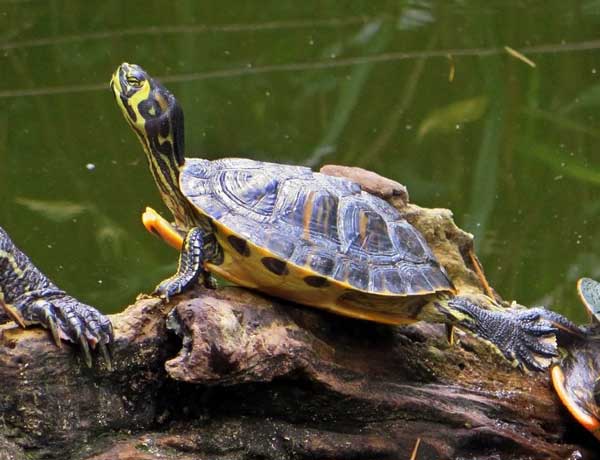
How to set up a yellow-bellied slider tank (Step-by-step):
Once you have all the above essentials in place, setting up your pond slider tank becomes easy.
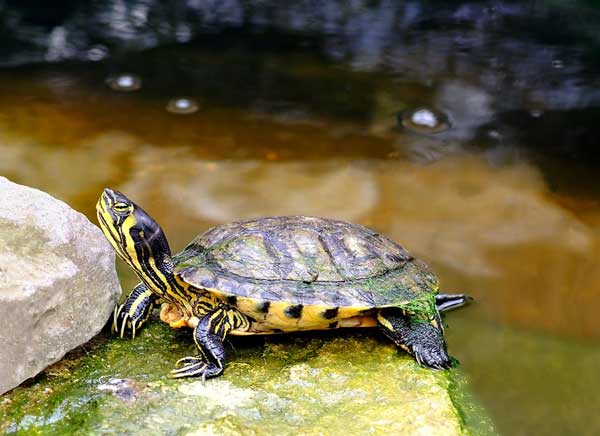
Here’s our step-by-step guide on how to do it:
Step 1. Choose the right yellowbelly turtle tank size
The perfect tank size for your adult yellow belly adult slider is around 75 to 100 gallons. However, the exact tank size depends on whether you have a male or female yellow belly slider. Females generally grow bigger than males.
As the rule of thumb goes, you should get a tank that’s around 10 gallons per inch of your turtle shell. A typical male around 7 inches will therefore require a 70-gallon tank. An average female of around 11 inches, on the other hand, will require around a 15-gallons tank.
If you plan to keep more than yellow-bellied sliders, then you should add 5 to 10 gallons for each additional turtle you have.
When filling your tank with water, remember to treat the water with a conditioner before you put it into the tank. This will help remove chlorine, fluoride, and other additives that can negatively affect your pet turtle’s quality of life as well as affect your biological filter.
Step 2. Create a basking area
Once you have the right size of tank, you can then proceed to set up a basking dock. You can choose to buy a basking perch.
Or you can come up with a DIY basking perch. Alternatively, a large river rock does well as a basking spot for your turtle.
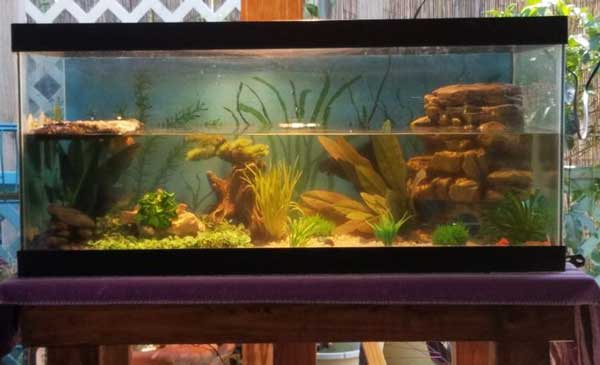
Whatever option you go with, make sure it’s stable and supports your turtle’s weight. It should also offer sufficient room for your turtle to comfortably bask and even move/turn around.
Step 3. Install the filtration system
As you already know, yellow-belly sliders eat and defecate in water. This makes them messy aquatic creatures. Unfortunately, this mess can make your tank water dirty and risk your turtle developing various health issues.
You can counter this by installing a water filtration system in your tank that traps all this waste and ensures your tank stays clean.
So, what kind of filter should you get? The experienced turtle owners recommend getting a filter that’s 2-3x the amount of water in your turtle tank. You can choose to use a submersible or canister water filter, but most experts recommend the latter.
Note that if you don’t install a filter in your yellow-bellied slider’s habitat, you’ll be forced to do weekly particle water changes, which can be time-consuming and even messy.
Step 4. Set up the heat source
Like the other turtles, a yellow belly slider is cold-blooded and depends on surrounding temperatures to regulate its body temperature.
Since you have an indoor spot and your turtle can’t access the sunlight, you can easily replicate the natural turtle habitat by providing him with a heat source on its basking spot.
The ideal temperature for the basking spot should be around 88 degrees Fahrenheit. A 60 to 100 Watt heat lamp will be sufficient to meet your turtle’s heat needs.
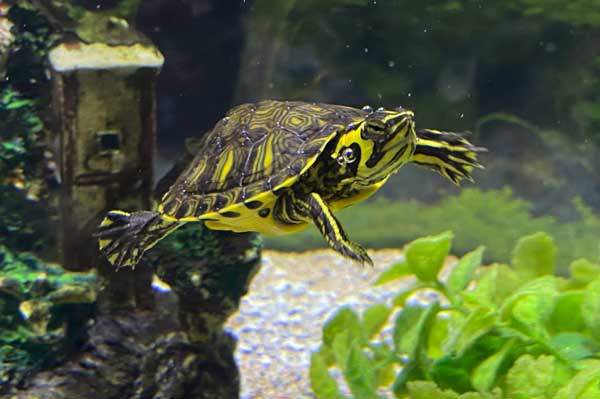
Besides the water should also be maintained at a constant temperature. The ideal yellow-bellied slider water temperature should be 75 to 80 degrees Fahrenheit.
Installing a water heater in your tank will help you keep the water at around this temperature. Be sure to maintain the temperature day and night.
Step 5. Mount the UV lamp
Your turtle also requires UVB rays for healthy development of its skin. The rays enable your pet turtle to produce vitamin D3 which plays a crucial role in allowing proper calcium metabolism.
Lack of it can therefore cause health issues for your turtles.
Luckily, you can achieve this by installing a UV-emitting bulb in your yellow belly slider’s indoor enclosure.
Make sure your turtle gets exposed to this UV light for around 1 hour every day, just like it gets exposure to natural sunlight every day.
And remember to replace your UV bulb every 6 to 9 months for continued efficiency in the production of UV rays.
Step 6. Yellow-bellied turtle aquarium décor
Décor isn’t a necessity for your slider’s indoor enclosure setup. However, it’s a nice finishing touch that helps make your tank more aesthetically pleasing and at the same time makes the environment look more natural for your pet.
You can consider live or artificial aquatic plants as part of your turtle tank décor. The added benefit of these plants is that they create tons of hiding spots for your turtle.
The substrate will also improve your aquarium’s looks. You can choose to line up the bottom of your turtle tank with gravel, river rocks, or sand. But avoid too small rocks which your turtle can easily ingest and lead to impaction and other health complications.
How do you set up yellow-bellied slider baby tank?
If you have a baby yellow-bellied slider, then its tank setup isn’t any different from that of an adult turtle we’ve discussed above.
You should follow the exact procedure above. Start by choosing the right tank size for your baby turtle.
One thing you should keep in mind though is that your bay turtle will outgrow a small “baby turtle-sized” tank and require a new one that comfortably accommodates it.
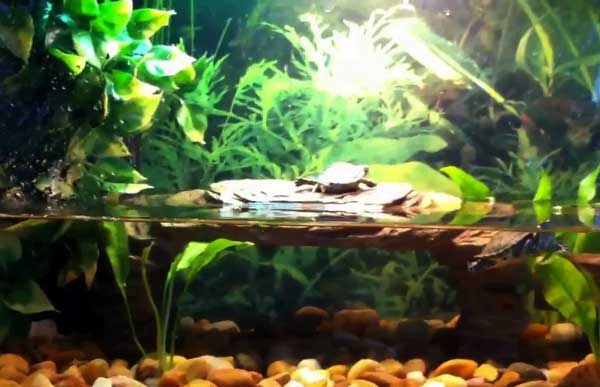
Once you get the right tank size, you can then go ahead and furnish your new baby yellow belly slider habitat with the necessary equipment including a water filter, water heater, heat lamp, UV light, and a basking platform.
The temperature settings for the basking spot and water should be the same as those of adult turtles.
How deep should the water be for a yellow belly slider?
The perfect water depth for a yellow belly slider turtle tank should be at least 12 inches deep. For larger female adults, the depth can go as high as 12 inches.
Some experts recommend a 16 to18 inches depth of water for your yellow belly sliders.
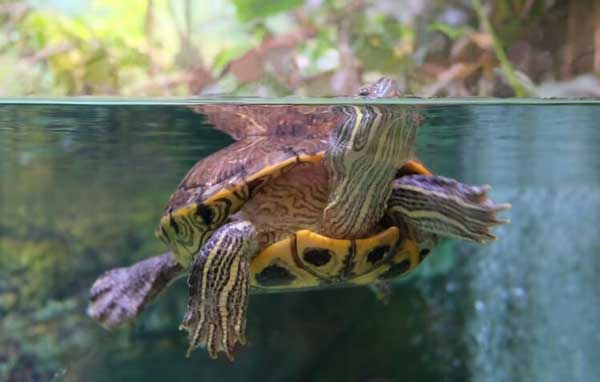
Yellow belly sliders usually inhabit deep ponds or rivers in the wild. So, it makes perfect sense why a depth of around 12 to 18 inches will suit them in terms of comfortably submerging and comfortably swimming in their new habitat.
What lights do yellow belly sliders need?
The most crucial lighting requirements for your yellow belly slider indoor enclosure include a UV light and a basking light.
As we said earlier, your turtle depends on UV light to produce vitamin D3 and properly absorb calcium. Lack of these nutrients can lead to health problems such as metabolic bone disease, which is a nightmare for your pet turtle.
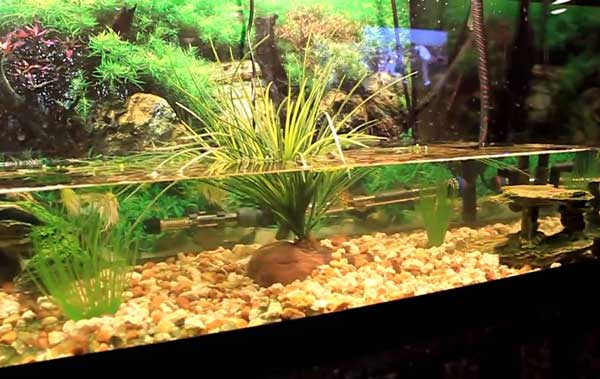
The basking helps produce the heat needed to provide optimal ambient temperatures for your turtle when it’s on land or basking. It also helps dry off your turtle’s shell and keep it healthy.
FAQs:
Since yellow belly turtles are semi-aquatic creatures, they need both a swimming area filled with clean water and dry land or basking perch in their tank. Additional equipment you need to put in their tank to help create an ideal environment includes a filtration system, heat source, and UV light source.
You don’t need to keep the light on for your yellow-bellied turtle’s habitat. The ideal habitat should mirror the turtle’s natural habitat, where there are no lights at night.
With good care, which includes a suitable habitat, you can expect your yellow-bellied slider turtle to last for as many as 25 years or so.
Final Verdict
The way you set up your yellow-bellied turtle habitat can greatly impact its health and overall well-being. To ensure your pet stays happy, remember to get them a large sized tank where they can freely swim and roam around. Also, provide a basking platform, basking area, heat lamp, UV light source, water filter, and a water filter to keep the tank clean.
Follow the step-by-step guide we’ve outlined above to set up a yellow belly turtle habitat. Make sure you set the correct temperatures for the tank water and the basking area. With this proper housing setup, your turtle species will live a happy and healthy life for many years to come.
